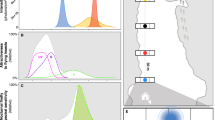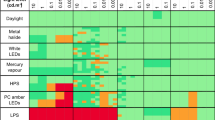Abstract
Though a number of effects of artificial light pollution on behavior and physiology have been described, there is little understanding of their consequences for the growth and distribution of populations. Here, we document impacts of light pollution on aspects of firefly population ecology and underlying mating behaviors. Many firefly species have a unique communication system whereby bioluminescent flashes are used in courtship displays to find and attract mates. We performed a series of manipulative field experiments in which we quantified the effects of adding artificial nighttime lighting on abundances and total flashing activity of fireflies, courtship behaviors and mating between tethered females and free-flying males, and dispersal distances of marked individuals. We show that light pollution reduces flashing activities in a dark-active firefly species (Photuris versicolor) by 69.69 % and courtship behavior and mating success in a twilight-active species (Photinus pyralis). Though courtship behavior and mating success of Photinus pyralis was reduced by light pollution, we found no effects of light pollution on male dispersal in this species. Our findings suggest that light pollution is likely to adversely impact firefly populations, and contribute to wider discussions about the ecological consequences of sensory pollution.





Similar content being viewed by others
References
Allard HA (1931) The photoperiodism of the firefly Photinus pyralis Linn. Its relation to the evening twilight and other conditions. Proc Ent Soc Wash 33:153
Azam C, Kerbiriou C, Vernet A et al (2015) Is part-night lighting an effective measure to limit the impacts of artificial lighting on bats? Glob Chang Biol 21:4333–4341. doi:10.1111/gcb.13036
Bauer CM, Nachman G, Lewis SM et al (2013) Modeling effects of harvest on firefly population persistence. Ecol Modell 256:43–52. doi:10.1016/j.ecolmodel.2013.02.018
Bee M, Swanson EM (2007) Auditory masking of anuran advertisement calls by road traffic noise. Anim Behav 74:1765–1776. doi:10.1016/j.anbehav.2007.03.019
Bird S, Parker J (2014) Low levels of light pollution may block the ability of male glow-worms (Lampyris noctiluca L.) to locate females. J Insect Conserv 18:737–743. doi:10.1007/s10841-014-9664-2
Buck JB (1937) Studies on the firefly. I. The effects of light and other agents on flashing in Photinus pyralis, with special reference to periodicity and diurnal rhythm. Physiol Zool 10:45–58
Candolin U, Salesto T, Evers M (2007) Changed environmental conditions weaken sexual selection in sticklebacks. J Evol Biol 20(1):233–239
Cinzano P, Falchi F, Elvidge CD (2001) The first World Atlas of the artificial night sky brightness. Mon Not R Astron Soc 328(3):689–707
Costello R, Symes LB (2014) Effects of anthropogenic noise on male signaling behaviour and female phonotaxis in Oecanthus tree crickets. Anim Behav 95:15–22. doi:10.1016/j.anbehav.2014.05.009
Cratsley CK, Lewis SM (2005) Seasonal variation in mate choice of Photinus ignitus fireflies. Ethology 111:89–100. doi:10.1111/j.1439-0310.2004.01049.x
Dreisig H (1974) Observations on the luminescence of the larval glowworm, Lampyris noctiluca. Insect Syst Evol 5:103–109
Dreisig H (1975) Environmental control of the daily onset of luminescent activity in glowworms and fireflies (Coleoptera: Lampyridae). Oecologia 18:85–99
Eisenbeis G (2006) Artificial night lighting and insects: attraction of insects to streetlamps in a rural setting in Germany. In: Rich C, Longcore T (eds) Ecological consequences of artificial night lighting. Island Press, Washington, DC, pp 281–304
Elvidge CD, Keith DM, Tuttle BT, Baugh KE (2010) Spectral identification of lighting type and character. Sensors 10:3961–3988. doi:10.3390/s100403961
Faust L, De Cock R, Lewis S (2012) Thieves in the night: kleptoparasitism by fireflies in the genus Photuris Dejean (Coleoptera: Lampyridae). Coleopt Bull 66:1–6
Francis CD, Barber JR (2013) A framework for understanding noise impacts on wildlife: an urgent conservation priority. Front Ecol Environ 11:305–313. doi:10.1890/120183
Frank KD (2006) Effects of artificial night lighting on moths. In: Rich C, Longcore T (eds) Ecological consequences of artificial night lighting. Island Press, Washington, DC, pp 345–364
Gaston KJ, Bennie J (2014) Demographic effects of artificial nighttime lighting on animal populations. Environ Rev 8:1–8. doi:10.1139/er-2014-0005
Gaston KJ, Duffy JP, Gaston S et al (2014) Human alteration of natural light cycles: causes and ecological consequences. Oecologia 176:917–931. doi:10.1007/s00442-014-3088-2
Girling RD, Lusebrink I, Farthing E et al (2013) Diesel exhaust rapidly degrades floral odours used by honeybees. Sci Rep 3:5. doi:10.1038/srep02779
Hagen O et al (2015) Artificial night lighting reduces firefly (Coleoptera: Lampyridae) occurrence in Sorocaba, Brazil. Adv Entomol 3:24–32
Hori M et al (1978) Natural population of adult of Luciola cruciata. Insectarium 15:4–11
Lall AB, Worthy KM (2000) Action spectra of the female’s response in the firefly Photinus pyralis (Coleoptera: Lampyridae): evidence for an achromatic detection of the bioluminescent optical signal. J Insect Physiol 46:965–968. doi:10.1016/S0022-1910(99)00206-1
Lall AB, Seliger HH, Biggley WH, Lloyd JE (1980) Ecology of colors of firefly bioluminescence. Science 210:560–562
Lewis SM, Wang OT (1991) Reproductive ecology of two species of Photinus. Pysche 98:293–307. doi:10.1155/1991/76452
Lewis SM, Cratsley CK, Rooney Ja (2004) Nuptial gifts and sexual selection in Photinus fireflies. Integr Comp Biol 44:234–237. doi:10.1093/icb/44.3.234
Lloyd JE (1966) Studies on the flash communication of Photinus fireflies, vol 130. Miscellaneous Publications, Museum of Zoology, University of Michigan, pp 1–96
Lloyd JE (1971) Bioluminescent communication in insects. Annu Rev Entomol 16:97–122
Lloyd JE (1980) Male Photuris fireflies mimic sexual signals of their females’ prey. Science 210:669–671. doi:10.1126/science.210.4470.669
Lloyd JE (1990) Firefly semiosystematics and predation: a history. Fla Entomol 73:51–66
Lloyd JE (2006) Stray light, fireflies, and fireflyers. In: Rich C, Longcore T (eds) Ecological consequences of artificial night lighting. Island Press, Washington, DC, pp 345–364
Longcore T, Rich C (2004) Ecological light pollution. Front Ecol Environ 2:191–198. doi:10.1890/1540-9295(2004)002[0191:ELP]2.0.CO;2
McFrederick QS, Kathilankal JC, Fuentes JD (2008) Air pollution modifies floral scent trails. Atmos Environ 42:2336–2348. doi:10.1016/j.atmosenv.2007.12.033
Merritt DJ, Rodgers EM, Amir AF, Clarke AK (2012) Same temporal niche, opposite rhythmicity: two closely related bioluminescent insects with opposite bioluminesce propensity rhythms. Chronobiol Int 29:1336–1344. doi:10.3109/07420528.2012.728549
Miller PJO, Biassoni N, Samuels A et al (2000) Whale songs lengthen in response to sonar. Nature 405:903. doi:10.1038/35016148
Perkin EK, Hölker F, Tockner K (2014) The effects of artificial lighting on adult aquatic and terrestrial insects. Freshwater Biol 59(2):368–377
Picchi MS, Avolio L, Azzani L et al (2013) Fireflies and land use in an urban landscape: the case of Luciola italica L. (Coleoptera: Lampyridae) in the city of Turin. J Insect Conserv 17:797–805. doi:10.1007/s10841-013-9562-z
Proppe DS, Sturdy CB, St Clair CC (2013) Anthropogenic noise decreases urban songbird diversity and may contribute to homogenization. Glob Chang Biol 19:1075–1084. doi:10.1111/gcb.12098
Quinn G, Keough M (2002) Experimental design and data analysis for biologists. Cambridge University Press, Cambridge
Rau P (1932) Rhythmic periodicity and synchronous flashing in the firefly, Photinus pyralis, with notes on Photurus pennsylvanicus. Ecology 13:7
Rich C, Longcore T (eds) (2006) Ecological consequences of artificial night lighting. Island Press, Washington, DC
Rotics S, Dayan T, Kronfeld-Schor N (2011) Effect of artificial night lighting on temporally partitioned spiny mice. J Mamm 92:159–168. doi:10.1644/10-MAMM-A-112.1
Scott GR, Sloman KA (2004) The effects of environmental pollutants on complex fish behaviour: integrating behavioural and physiological indicators of toxicity. Aquat Toxicol 68:369–392. doi:10.1016/j.aquatox.2004.03.016
Slabbekoorn H (2013) Songs of the city: noise-dependent spectral plasticity in the acoustic phenotype of urban birds. Anim Behav 85:1089–1099
Slabbekoorn H, Bouton N, van Opzeeland I et al (2010) A noisy spring: the impact of globally rising underwater sound levels on fish. Trends Ecol Evol 25:419–427. doi:10.1016/j.tree.2010.04.005
Small C, Pozzi F, Elvidge C (2005) Spatial analysis of global urban extent from DMSP-OLS night lights. Remote Sens Environ 96:277–291. doi:10.1016/j.rse.2005.02.002
Steele R (2010) Strategically speaking: LCD backlights and lighting drive largest growth yet seen in HB-LED market. LEDs Mag 2:3–26
Takeda M, Amano T, Katoh K (2006) The habitat requirement of the Genji-firefly Luciola cruciata (Coleoptera: Lampyridae), a representative endemic species of Japanese rural landscapes. Biodivers Conserv 15:191–203. doi:10.1007/s10531-004-6903-y
Van der Reijden ED, Monchamp JD, Lewis SM (1997) The formation, transfer, and fate of spermatophores in Photinus fireflies (Coleoptera: Lampyridae). Can J Zool 75:1202–1207. doi:10.1139/z97-143
van Geffen KG, van Eck E, de Boer RA (2015) Artificial light at night inhibits mating in a geometrid moth. Insect Conserv Divers 8:282–287. doi:10.1111/icad.12116
Viviani VR, Rocha MY, Hagen O (2010) Fauna de besouros bioluminescentes (Coleoptera: Elateroidea: Lampyridae; Phengodidae, Elateridae) nos municípios de Campinas, Sorocaba-Votorantim e Rio Claro-Limeira (SP, Brasil): biodiversidade e influência da urbanização. Biota Neotrop 10:103–116. doi:10.1590/S1676-06032010000200013
Wong BBM, Candolin U, Lindström K, Lindstro K (2007) Signals of male quality in three-spined sticklebacks. Am Nat 170:184–189. doi:10.1086/519398
Woods W, Hendrickson H, Mason J, Lewis SM (2007) Energy and predation costs of firefly courtship signals. Am Nat 170:702–708. doi:10.1086/521964
Yuma M, Ono K (1985) Seasonal changes and population estimate of the adult firefly, Luciola cruciata (Coleoptera: Lampyridae), along the Biwako canal, Kyoto city. Sci Rep Yokosuka City Mus 33:1–11
Acknowledgments
We thank D. Heflin and B. Fox for the construction of light fixtures, B. Manning for help with data collection, D. Carr for statistical support, and J. Walter and T. Roulston for comments on the manuscript. Additional thanks to C. Bielecki, B. Cook, K. Fu, E. Graves, T. Hartman, S. Heitsch, I. Keddy-Hector, M. Glebocki, K. LeCroy, J. Linnaburg, E. McGee, A. Pheil, C. Taylor, and K. Ware for help with data collection, and to BEF administrative and support staff for facilitating a vibrant research community. Financial support was provided by Sigma Xi, BEF, and the University of Virginia Department of Environmental Sciences.
Author contribution statement
A. F. and K. H. conceived and designed the experiments. A. F. performed the experiments. A. F. and K. H. analyzed the data and wrote the manuscript.
Author information
Authors and Affiliations
Corresponding author
Additional information
Communicated by Roland A. Brandl.
Rights and permissions
About this article
Cite this article
Firebaugh, A., Haynes, K.J. Experimental tests of light-pollution impacts on nocturnal insect courtship and dispersal. Oecologia 182, 1203–1211 (2016). https://doi.org/10.1007/s00442-016-3723-1
Received:
Accepted:
Published:
Issue Date:
DOI: https://doi.org/10.1007/s00442-016-3723-1




